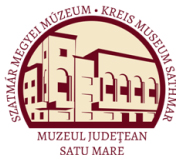Drăgan, Ioan (szerk.): Mediaevalia Transilvanica 2001-2002 (5-6. évfolyam, 1-2. szám)
Etnie şi confesiune
Biserica din Bârsău în secolele XV-XVl 111 spaţiu funerar privat100. Nu avem indicii despre hramul iniţial, dar cel de după rectitorire a devenit Sfântul Nicolae, patronul spiritual al lui Cherepovici. Toate acestea se pot atribui unei perioade din timpul celor două personaje ale imaginii votive. Absenţa lui Cherepovici din rândul lor, opţiunea de a închina ctitoria sfântului care îi era patron şi inscripţiile lapidare care îi pomenesc numele, asociate cu textul inscripţiei pictate, care o prezintă pe Catarina drept soţie a lui Valentin Török, dau ca răstimp de realizare a picturii intervalul 1562-1572101. Nominalizarea târzie a Maréi în documentele scrise, mai târzie decât a celorlalţi membri ai familiei, invocarea testamentului ei într-o sursă din secolul al XVII- lea102, apariţia numelui său şi pe lespedea care poartă anul 1589 argumentează, nu doar că ea a fost în proprietatea moşiei, ci şi că a fost persoana care şi-a asumat responsabilitatea îngrijirii sufletelor celor apropiaţi. New Remarks on a Topic with Few Sources: the Church of Bârsău in the 15"1 and 16,h Centuries (Abstract) The author investigates the case of the medieval church of Bârsău, a Romanian villages situated in the former Hunedoara County. The village was not mentioned in the medieval written sources. The first investigation on the church belongs to Károly Torma, who published a study in 1879. This article contains a great deal of useful data, but in the same time mistakes too. Torma discovered frescoes in the church: a votive picture displaying two ladies from the family of Nicolas Cherepovici, a Serbian nobleman. Slavonic inscriptions accompany the image, and in the church are several fragmentary inscriptions on funerary stones, too. Due to a wrong assumption- that the medieval church was demolished until 1966 the scholars believed that the present building was a reconstruction made in the nineteenth century. Therefore, no special attention was granted to the building, assuming that it is not worth for historical research. In fact, the church was extensively repaired and under the cement plaster, the original frescoes were preserved. Between 1882 and 1886, Gábor Szinte and Miklós Horváth made sketches on the ground-plan of the church, on the frescoes and on the funeral stones. Unfortunatelly, these sketches were not available to the Romanian scholars before 1989. During the last decades both the frescoes and their copies are accesible to the scholarly research. On the basis of these iconographic sources, combined with the written, and archaeological ones, the autor identified the persons of the female founders and the patron-saint of the church represented on the frescoes. The ladies are the wife and the daughter of Nicolas Cherepovici: Mara or Margareta and Catarina. The author analyses the conditions of obtaining the domain of Bârsău by the Cherepovici family, and the reasons why they repaired and re-painted the church. The Cherepovici family received the village of Bârsău by inheritance from Mara’s father (Peter Ovcarovici), as it is mentioned in a source reffering to the domain of Şoimuş (Hunedoara County) or by a donation from Izabella Zápolya. The first variant is supported by the fact that in several documents from the I5'h 100 Menţinut şi în secolul al XVII-lea, probabil de cei care au preluat posesiunea cu biserica, după care înmormântările îşi pierd caracterul exclusiv. în acelaşi secol este datată şi o reamenajare a criptei care a funcţionat până în secolul al XVlil-lea: Luminţa Dumitriu, op. cit., p. 191. 101 Pănă acum datată înainte de 1563: M. Porumb, Pictura românească ..., p. 68, sau în jurul lui 1570: V. Drăguţ, Pictura murală ..., p. 68, în funcţie de prezenţa Elenei în Transilvania. 102 După moartea Maréi, rămasă fără urmaşi direcţi, posesiunea a fost revendicată de Sigismund Bálintiéi: S. Dragomir, op. cit., p. 147, cu care se înrudea prin sora ei Elena, căsătorită cu un antecesor - Ştefan Bálintiéi: Kővári L., Erdély nevezetesebb családai, Kolozsvár, 1854, p. 18.
